MINERALS & ENERGY RESOURCES -PRESENTED BY GRADE 10 D F L I P B O O K 1
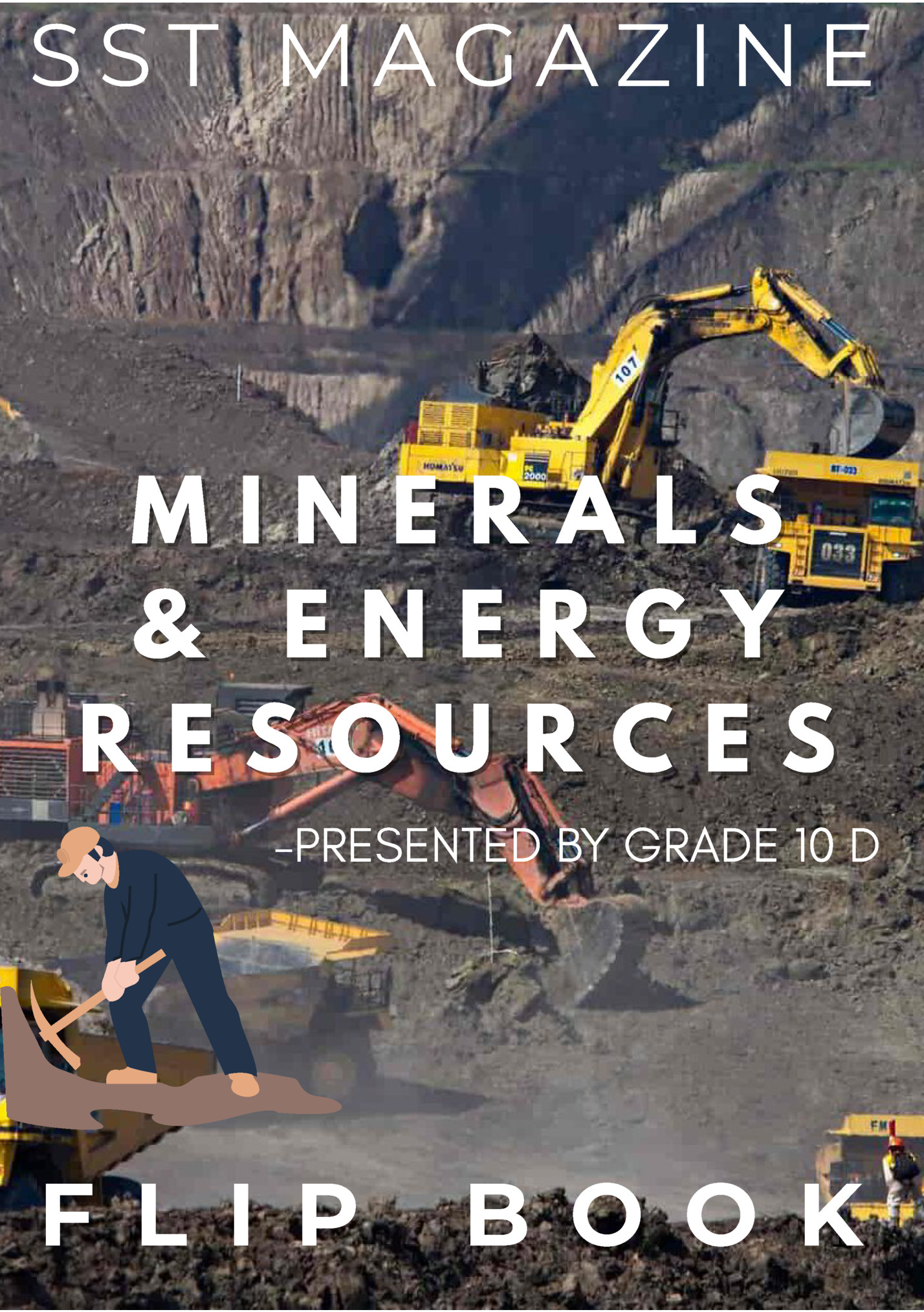
Timeline PREHISTORIC ERA MIDDLE AGES RN DE O M 3300–1200 BCE ES M TI 1 2 3 4 5 Early tools (flint, obsidian) Bronze Age (copper + tin) Middle Ages (silver, gold mining) Start of Development Modern times (sustainable mining, synthetic minerals) 1. THE HISTORY OF MINING: A JOURNEY THROUGH TIME MINING HAS BEEN A TRANSFORMATIVE FORCE THROUGHOUT HUMAN HISTORY, SHAPING CIVILIZATIONS FROM THE DAWN OF TIME. PREHISTORIC BEGINNINGS: EARLY HUMANS CRAFTED TOOLS FROM MINERALS LIKE FLINT AND OBSIDIAN FOR THEIR SHARPNESS AND UTILITY IN SURVIVAL. THE BRONZE AGE (3300–1200 BCE): THE DISCOVERY OF COPPER AND TIN LED TO THE CREATION OF BRONZE, REVOLUTIONIZING TOOLS, WEAPONS, AND ART. MIDDLE AGES: MINING EXPANDED SIGNIFICANTLY IN EUROPE, ESPECIALLY FOR GOLD AND SILVER, FUELING ECONOMIC GROWTH AND WEALTH. MODERN MINING: TODAY, SUSTAINABILITY AND INNOVATION ARE THE FOCUS, WITH ADVANCEMENTS LIKE SYNTHETIC MINERALS (E.G., CUBIC ZIRCONIA) REDUCING RELIANCE ON NATURAL GEMSTONES
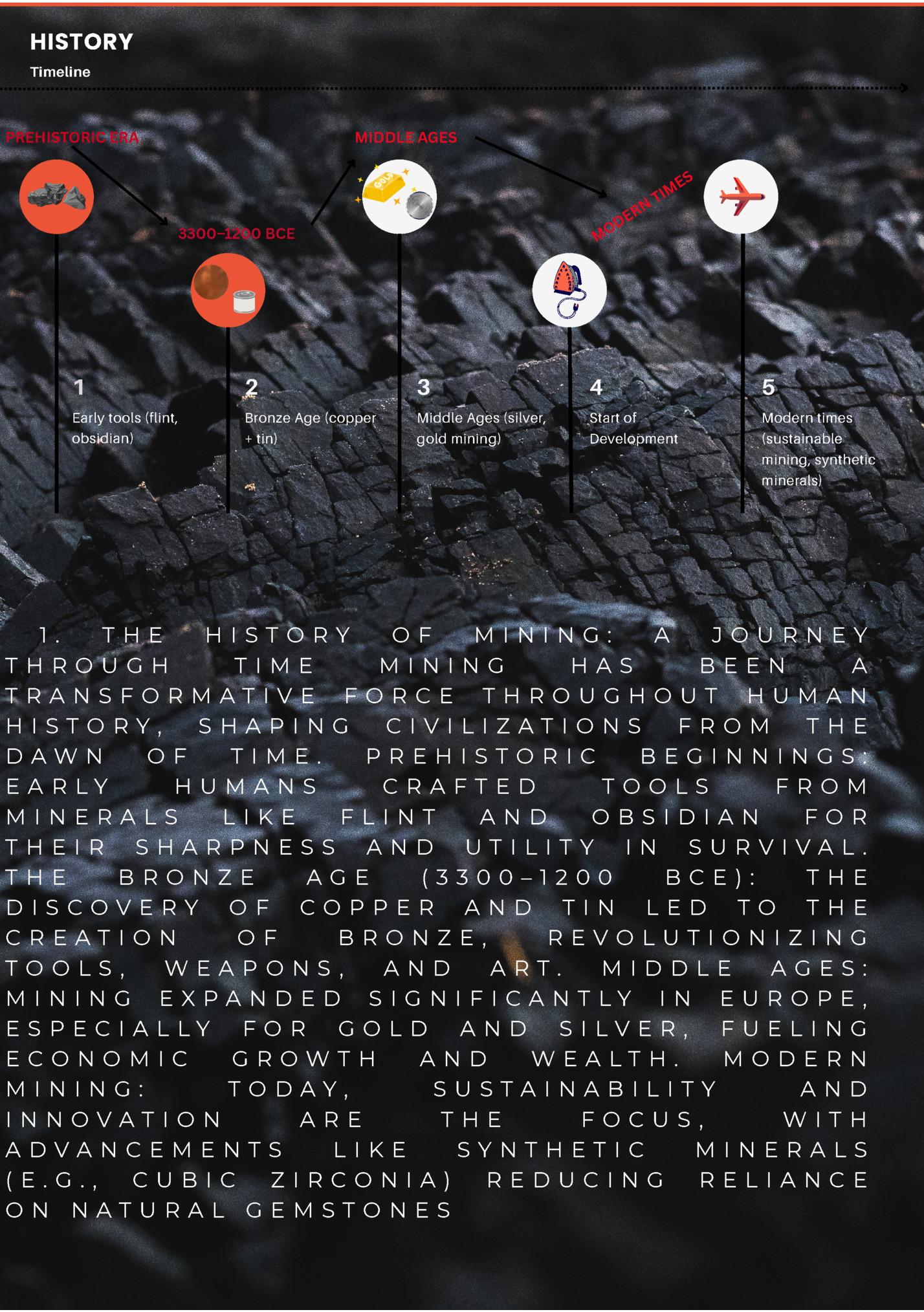
unevenly spread across the globe, with some regions holding vast reserves. Iron Ore: Australia holds 37% of global iron ore reserves, with Brazil (18%) and China (11%) following. Copper: Chile is the dominant producer, contributing 23.6% of global copper, with DRC (14%) and Peru (11%) also significant contributors 3. Metallic Minerals: Powering Industries Metallic minerals are vital for industrial use, supporting everything from construction to electronics. Ferrous Minerals: Iron ore (found in Odisha–Jharkhand) and manganese are essential for steel production. Non-Ferrous Minerals: Copper (from Balaghat and Khetri) is used in wiring and electronics. Gold mined in Hutti (Karnataka) serves both aesthetic and industrial purposes. Precious Metals: Gold, silver, and platinum have diverse applications in both industrial settings and jewelry. 4. Non-Metallic and Energy Minerals: The Building Blocks of Society Nonmetallic minerals and energy resources are the backbone of modern infrastructure and industry. Non-Metallic Minerals: Sand, gravel, and limestone are crucial for construction. Limestone is also key in cement production. Energy Minerals: Coal, petroleum, and natural gas form the foundation of global energy consumption. India heavily relies on coal, with major reserves in the Damodar Valley, while offshore fields in Mumbai High and Gujarat provide petroleum and natural gas.
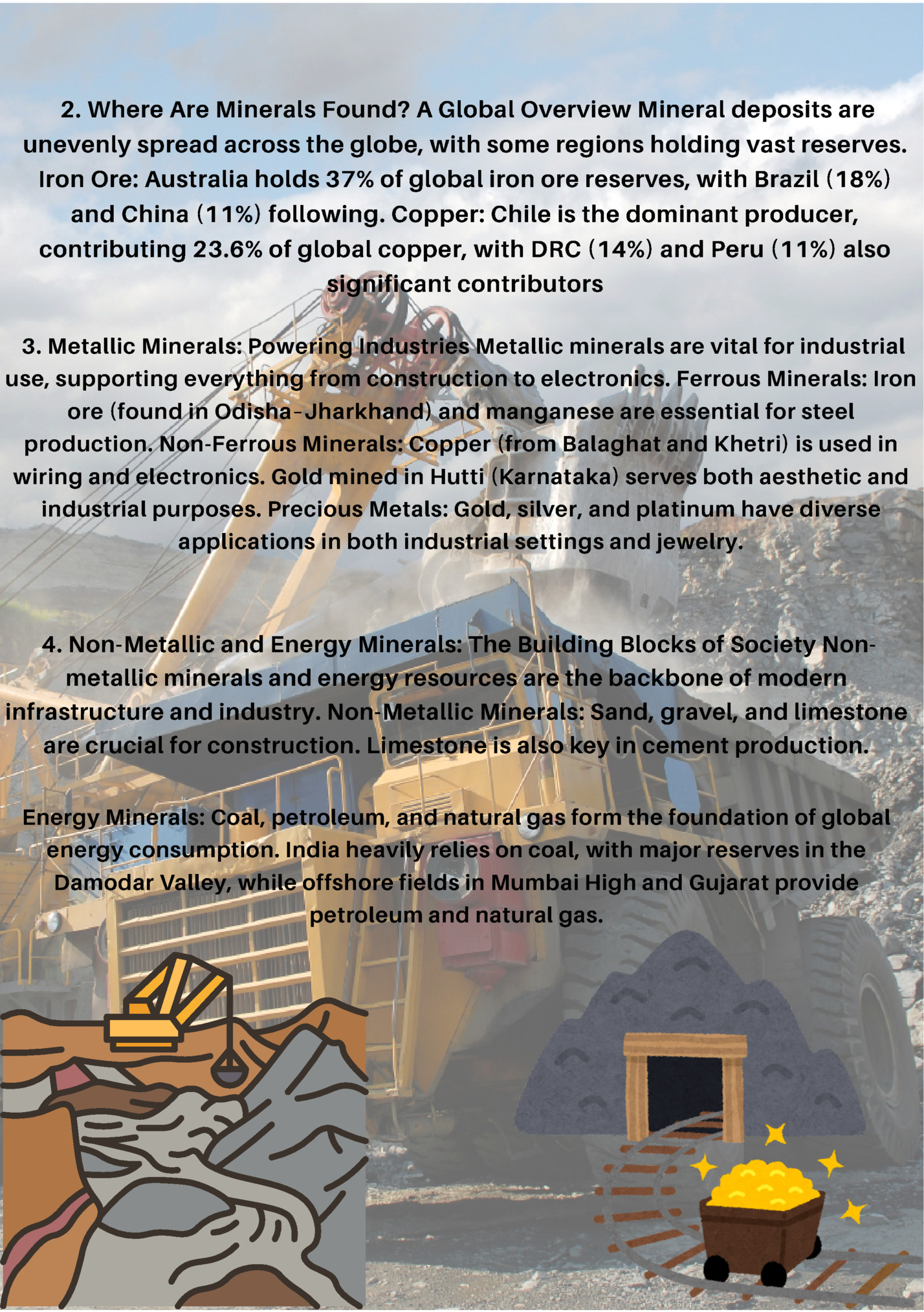
into conventional (non-renewable) and non-conventional (renewable). Conventional Energy: Coal, petroleum, and natural gas are non-renewable sources that power industries and transportation. Coal is India’s primary energy source. Non-Conventional Energy: Solar, wind, geothermal, and tidal energy are clean, renewable sources. India’s National Solar Mission aims for ambitious solar energy goals. 6. Extraction of Minerals: Methods and Technologies The extraction of minerals varies depending on their location and type. Open-Cast Mining: Common for surface minerals like coal and iron ore. Underground Mining: Used for deeper deposits of minerals such as gold and copper. Quarrying: Typically for non-metallic minerals like limestone and marble. 7. Distribution of Resources and Energy Minerals: A Global Perspective Resource distribution varies widely, with different regions holding strategic reserves. Mineral Reserves: Australia, Brazil, and India hold large iron ore and bauxite reserves. Russia, USA, and China are major coal producers. Energy Resources: The Middle East dominates global petroleum reserves, with Saudi Arabia, Iraq, and Iran being key producers. 8. Exploitation of Minerals and Resources: Challenges and Consequences Exploitation of resources leads to various environmental and socio-economic issues. Over-Exploitation: The excessive extraction of resources, especially nonrenewable ones like coal and petroleum, leads to depletion and environmental degradation. Illegal mining is another significant concern, as seen in Bellary (Karnataka). Case Study - Kolar Gold Mines: Once a thriving mine, Kolar Gold Mines has now been abandoned due to resource depletion and severe environmental damage, including cyanide pollution.
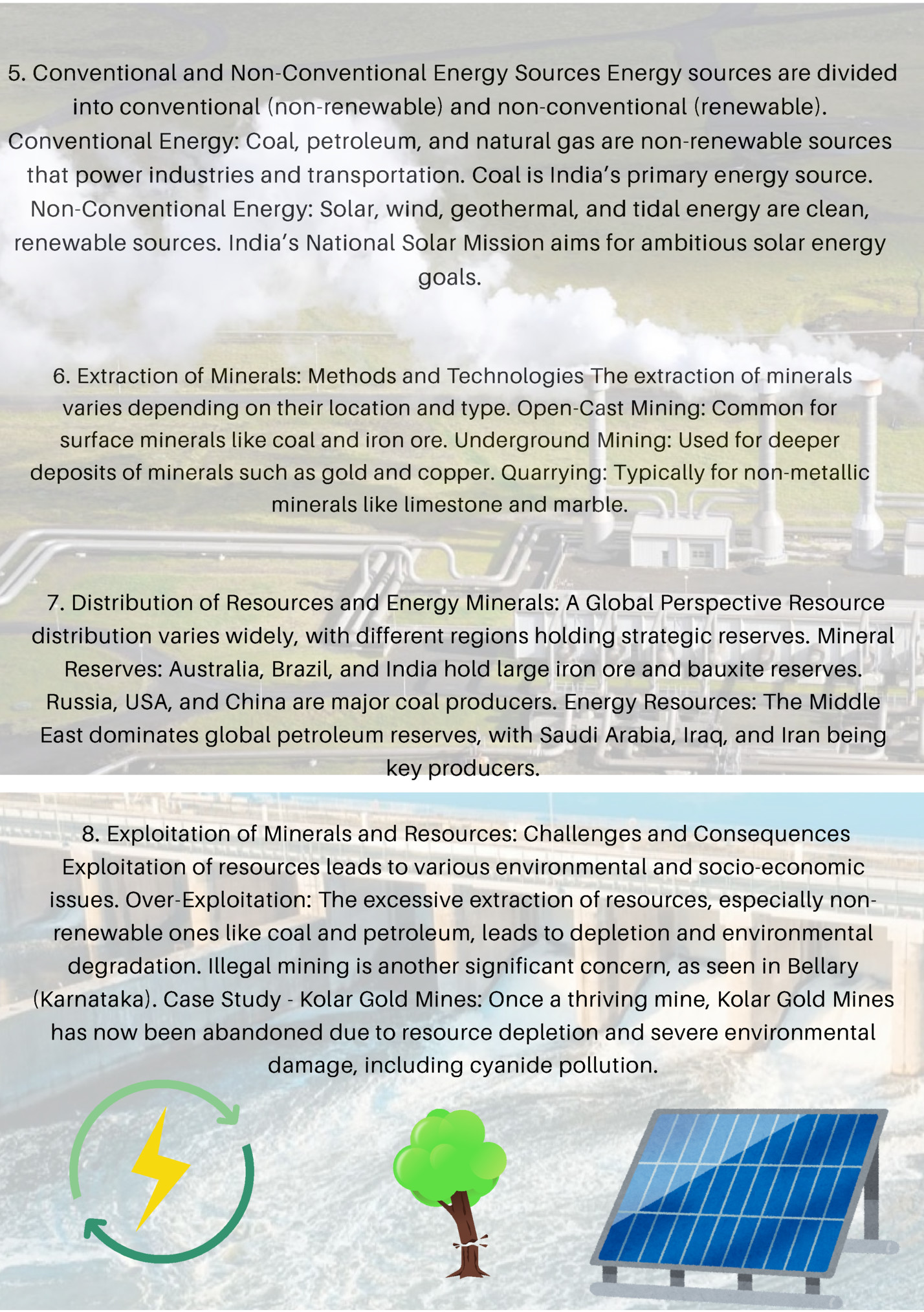
resource management is key to long-term availability. Recycling: Recycling metals like aluminum, copper, and iron significantly reduces the need for new mining. Aluminum recycling alone saves up to 95% of energy. Substitution: Technologies like fiber-optic cables replacing copper reduce mineral demand. Sustainable Mining Practices: Methods like underground mining, remote sensing, and controlled blasting minimize environmental harm. 10. Nationwide Troubles: The Socio-Economic and Environmental Impacts Mineral extraction impacts the environment, society, and economy in significant ways. Environmental Impact: Mining leads to deforestation, air pollution, and soil erosion. Jharia coal fires are a key example of long-term environmental damage. Human Health Impacts: Exposure to chemicals like mercury and lead causes lung diseases and neurotoxicity among miners. Social Impacts: Mining leads to displacement of communities, as seen with the Dongria Kondh tribe in Niyamgiri Hills (Odisha), and child labor in regions like Congo. 11. Environmental and Human Health Impacts The environmental and health impacts of mining are severe and far-reaching. Deforestation: Mining for resources like bauxite and coal destroys habitats, as seen in Niyamgiri Hills, where mining threatens the livelihoods of indigenous tribes. Air and Water Pollution: Mining operations contaminate the environment, as seen in Kolar Gold Mines, which caused cyanide contamination, and the Jharia coal fires, which release harmful pollutants into the air. Health Hazards: Miners suffer from lung diseases and exposure to toxic substances, leading to long-term health issues, such as those faced by Dhanbad coal miners exposed to coal dust.
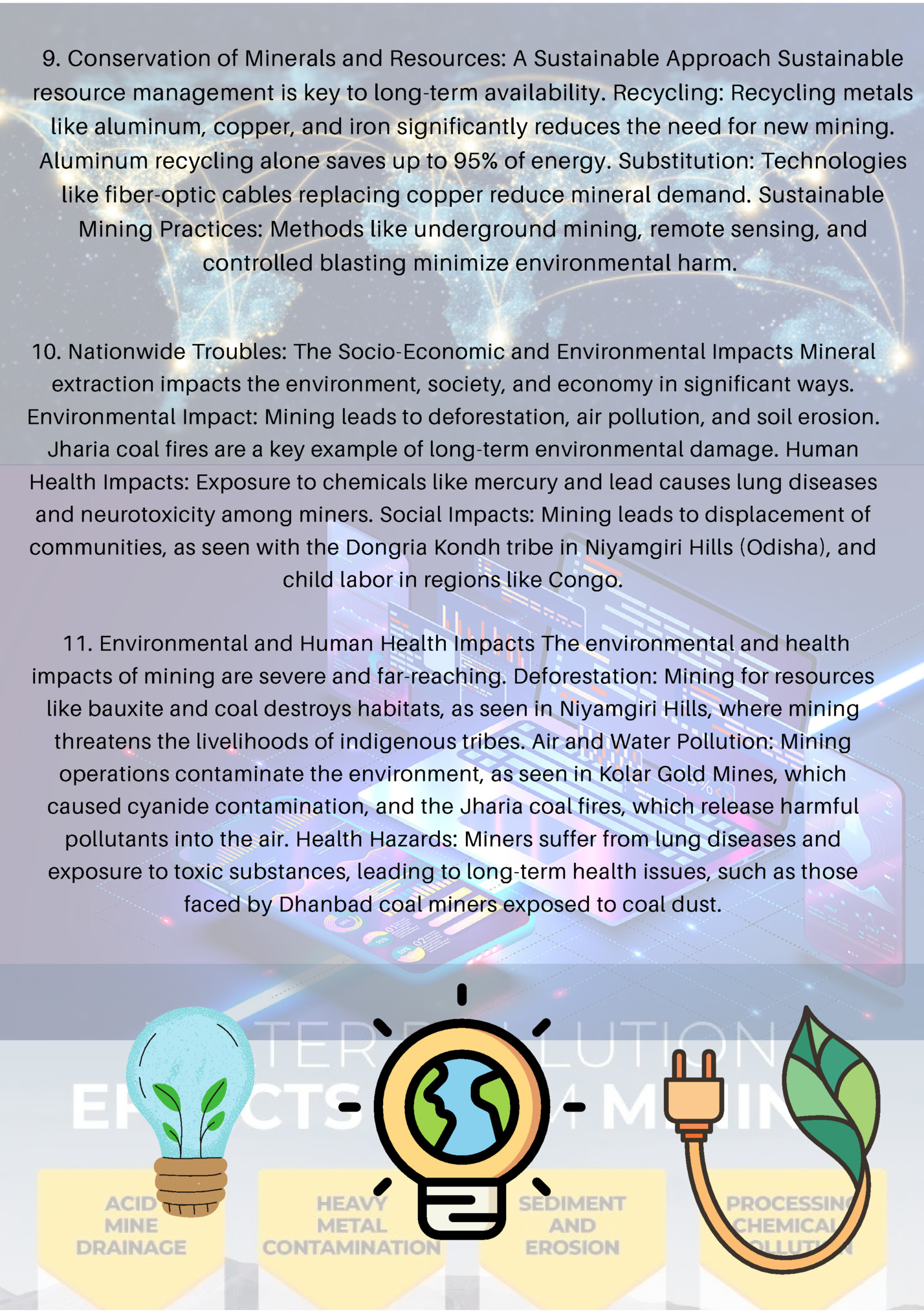
consequences, both positive and negative. Social Impacts: Mining causes displacement of communities, such as over 1.05 lakh families displaced in Jharia. Niyamgiri Gram Sabha successfully resisted bauxite mining, defending indigenous rights. Economic Impacts: Mining generates revenue, but it can also cause economic instability due to the resource curse. Illegal mining and fluctuating markets often create inequality. Child Labor: In places like the Congo, children work in hazardous conditions, particularly in cobalt mines, affecting over 40,000 children. 13. Political and Security Impacts Mineral resources are often linked to political instability and conflict. Resource Conflicts: The fight for control over minerals, like blood diamonds in Sierra Leone and cobalt in Congo, has fueled civil wars and political instability. Protests and Disputes: Local communities, like the Niyamgiri Gram Sabha, successfully resisted mining projects, showcasing the power of collective action against destructive practices. Deep-Sea Mining Debate: Growing concerns about deep-sea mining and its environmental risks have led to calls for a pause on operations due to potential harm to marine life. 14. Case Highlights: Mining Disasters and Their Consequences Mining disasters underscore the risks of irresponsible extraction. Oil Spill, Gulf of Mexico (2010): The Deepwater Horizon disaster spilled 4.9 million barrels of oil, causing severe environmental damage and highlighting offshore drilling risks. Neyveli Lignite (Tamil Nadu): Mining in Neyveli caused land degradation, pollution, and community displacement. Solar Energy in Rajasthan: The Bhadla Solar Park serves as a successful example of renewable energy, reducing coal dependence and fostering sustainable development.
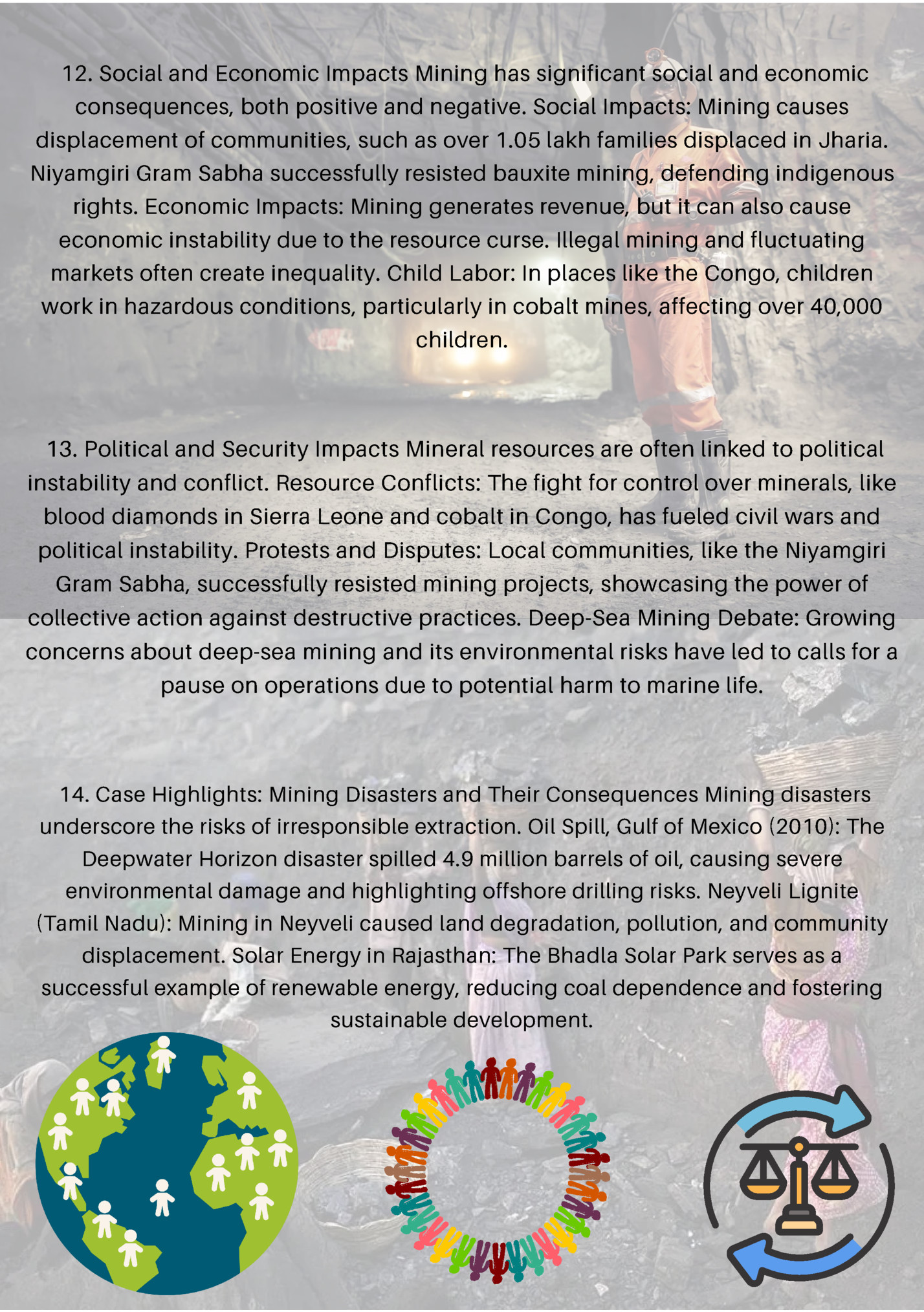
address growing challenges. Deep-Sea Mining: Countries like China and Nauru are pushing for deep-sea mining, but environmental groups are urging a pause due to unknown impacts on marine ecosystems. Global Actions to Prevent Conflict: Initiatives like the Kimberley Process aim to stop blood diamonds, and the UN International Seabed Authority regulates ocean mining to safeguard marine environments. 16. Global Actions and Sustainable Practices The future of mining lies in adopting sustainable practices and international collaboration. Recycling and Waste Minimization: Recycling metals like aluminum, copper, and iron can reduce the need for new extraction, with aluminum recycling saving 95% of energy compared to primary production. Renewable Energy Transition: Germany and China are leading the transition to renewable energy through investments in solar, wind, and geothermal energy. India is setting ambitious goals for solar energy as part of its National Solar Mission. Conclusion: The Path Forward As global demand for minerals and energy resources continues to rise, the world must focus on sustainable practices that minimize environmental damage, foster social equity, and ensure the availability of resources for future generations. By embracing clean energy, recycling, and sustainable mining technologies, we can create a future where economic growth doesn’t come at the expense of the planet.
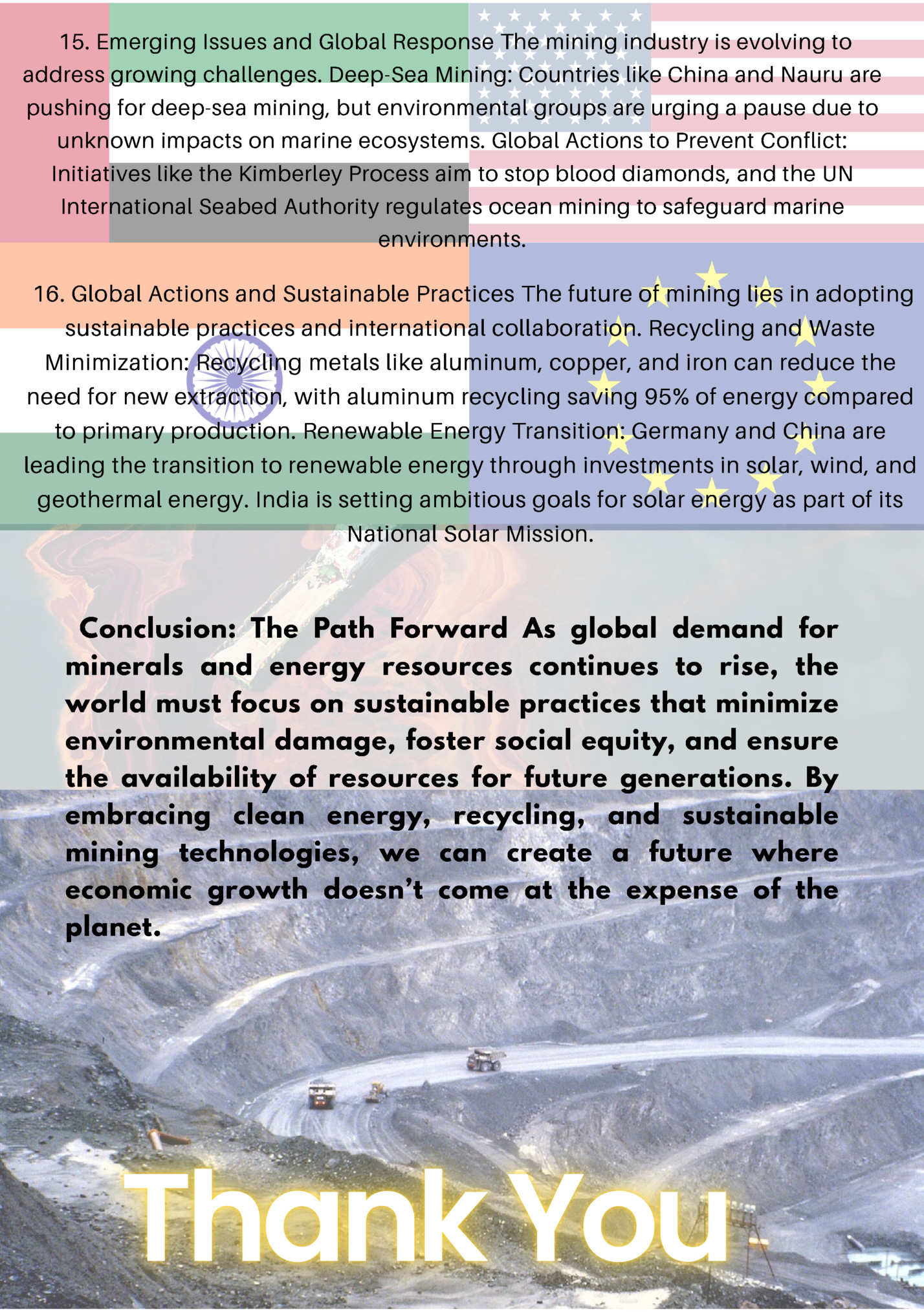
Fleepit Digital © 2021